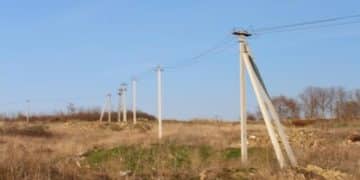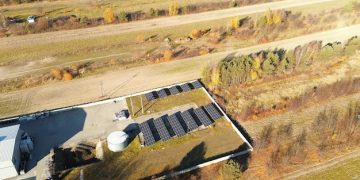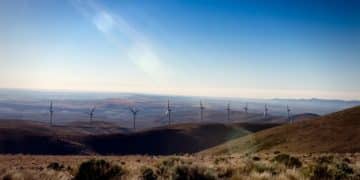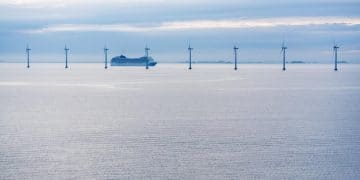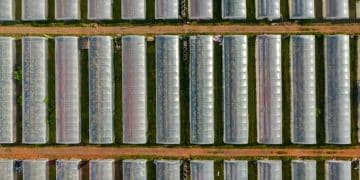US Renewable Energy Growth: Projecting the Next 5 Years
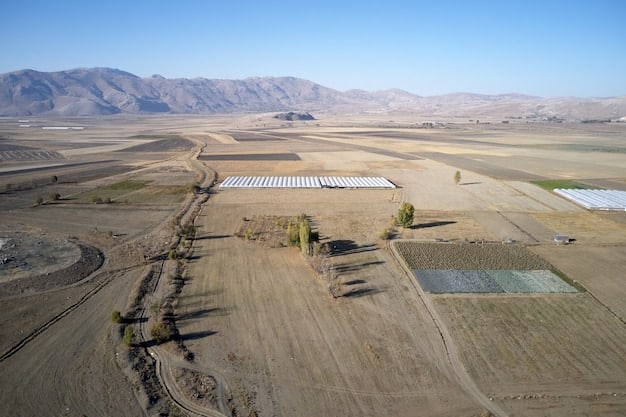
The projected growth rates for different renewable energy sources in the US over the next 5 years indicate a significant expansion, with solar and wind leading the charge, driven by policy incentives, technological advancements, and increasing cost-competitiveness.
The future of energy in the United States is undeniably leaning towards renewable sources. Understanding what are the projected growth rates for different renewable energy sources in the US over the next 5 years is crucial for investors, policymakers, and anyone interested in the energy transition.
Renewable Energy in the US: An Overview
Renewable energy is transforming the US energy landscape. As concerns about climate change intensify, the transition from fossil fuels to cleaner energy sources is becoming increasingly urgent. This section offers an overview of the current state and future trajectory of renewable energy in the US, focusing on the key factors driving its growth.
The shift towards renewable energy is not just an environmental imperative; it’s also an economic opportunity. Investments in renewable energy create jobs, stimulate innovation, and enhance energy security. Let’s delve into the forces shaping this dynamic sector.
Key Drivers of Renewable Energy Growth
Several factors are contributing to the expansion of renewable energy in the US. These drivers include supportive government policies, decreasing costs of renewable technologies, and growing consumer demand for sustainable energy solutions.
- Policy Incentives: Tax credits, subsidies, and renewable energy mandates at the federal and state levels are incentivizing investment in renewable energy projects.
- Technological Advancements: Innovations in solar, wind, and battery storage technologies are improving efficiency and lowering costs.
- Consumer Demand: Increasing awareness of climate change and the desire for cleaner energy options are driving demand for renewable energy among consumers and businesses.
These factors, combined with the increasing competitiveness of renewable energy compared to fossil fuels, are setting the stage for significant growth in the coming years.
In summary, the renewable energy sector in the US is experiencing rapid growth driven by a combination of policy support, technological advancements, and growing consumer demand. Understanding these underlying forces is crucial for projecting future growth rates.
Projected Growth of Solar Energy
Solar energy is poised for substantial growth in the US. Thanks to declining costs and increased efficiency, solar power is becoming an increasingly attractive option for both residential and commercial consumers. Let’s explore the projected growth rates for solar energy and the factors influencing its expansion.
The solar energy sector is not only expanding but also diversifying. From large-scale solar farms to rooftop solar panels, the applications of solar energy are becoming more versatile and accessible. Understanding these trends is key to grasping the full potential of solar energy in the US.
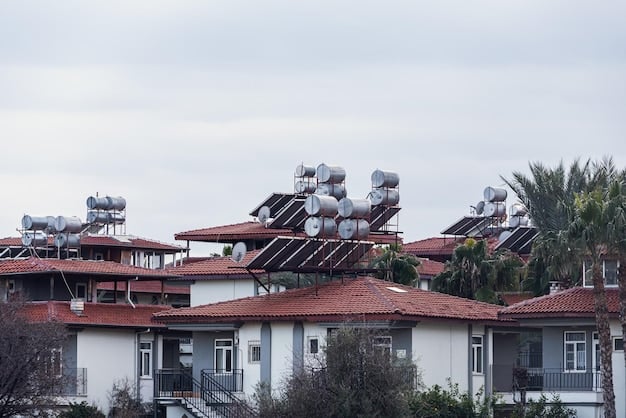
Factors Contributing to Solar Growth
Several factors contribute to the projected growth of solar energy. These include federal and state incentives, technological advancements, and the increasing affordability of solar panels.
- Federal tax credits: The Investment Tax Credit (ITC) provides a significant incentive for solar energy projects, reducing their upfront costs.
- State-level policies: Many states have renewable portfolio standards (RPS) that require utilities to generate a certain percentage of their electricity from renewable sources, driving demand for solar energy.
- Declining costs: The cost of solar panels has decreased dramatically over the past decade, making solar energy more competitive with fossil fuels.
These factors are expected to continue driving the growth of solar energy in the US, making it one of the fastest-growing renewable energy sources.
The solar energy sector is set for impressive growth, driven by a combination of cost reductions, technological advancements, and supportive policies. This growth will likely transform the energy landscape in the US.
Wind Energy: Onshore and Offshore Growth
Wind energy is another key player in the US renewable energy sector. Both onshore and offshore wind farms are expanding, contributing significantly to the nation’s clean energy supply. This section examines the projected growth rates for wind energy and the factors driving its development.
Wind energy harnesses the power of the wind to generate electricity. With advancements in turbine technology and increasing investments in wind farm infrastructure, wind energy is becoming an increasingly reliable and cost-effective source of renewable energy.
Onshore Wind Energy Projections
Onshore wind energy has been a significant contributor to the US renewable energy mix for many years. With continued technological improvements and cost reductions, onshore wind is expected to maintain a steady growth trajectory in the coming years.
The Midwest and Great Plains regions of the US are particularly well-suited for onshore wind development, with vast open spaces and consistent wind resources. These regions are expected to see continued investment in onshore wind farms.

Offshore Wind Energy Potential
Offshore wind energy represents a significant growth opportunity for the US. With access to stronger and more consistent winds than onshore locations, offshore wind farms have the potential to generate large amounts of clean electricity.
The development of offshore wind energy in the US has been slower than in Europe, but several large-scale projects are now underway along the Atlantic coast. These projects are expected to drive significant growth in the offshore wind sector in the coming years.
Wind energy, both onshore and offshore, is poised for substantial growth in the US. With continued investment and technological innovation, wind power will play an increasingly important role in the nation’s energy mix.
Hydropower’s Role in Renewable Energy Growth
Hydropower, or hydroelectric power, has long been a source of renewable energy in the United States. While already well-established, there are opportunities for growth, especially through upgrades to existing facilities and the development of pumped storage hydropower. This section explores the current state of hydropower and its potential for future growth.
Hydropower uses the energy of moving water to generate electricity. Dams and reservoirs are the most common form of hydropower, but there are also run-of-river projects that generate electricity without large reservoirs.
Current Hydropower Capacity
Hydropower currently accounts for a significant portion of the renewable energy generated in the US. However, the potential for new large-scale hydropower projects is limited due to environmental concerns and regulatory hurdles.
- Existing Infrastructure: Many hydropower facilities were built decades ago and are in need of upgrades to improve efficiency and environmental performance.
- Pumped Storage Hydropower: This technology involves pumping water from a lower reservoir to an upper reservoir during periods of low electricity demand and then releasing the water to generate electricity during peak demand.
Hydropower is expected to play a more stable role in supporting grid reliability and energy storage, rather than seeing major capacity additions. Upgrades can increase efficiency and reduce environmental impacts.
Hydropower will continue to be a vital renewable energy source, particularly through upgrades and energy storage applications, ensuring a reliable and clean energy supply for the future.
Geothermal and Biomass Energy: Niche Contributions
Geothermal and biomass energy sources offer unique contributions to the renewable energy sector. While not as widely deployed as solar or wind, they have specific applications and potential for growth in certain regions. This section examines the role of geothermal and biomass energy in the US renewable energy mix.
Geothermal energy harnesses the heat from the Earth’s interior to generate electricity or provide direct heating. Biomass energy involves burning organic matter, such as wood or agricultural waste, to produce electricity or heat.
Geothermal Energy Potential
Geothermal energy is a reliable and continuous source of renewable energy. However, it is geographically limited to areas with accessible geothermal resources, such as the western United States.
- Direct Use: This involves using geothermal heat directly for heating buildings, greenhouses, or industrial processes.
- Enhanced Geothermal Systems (EGS): EGS technology aims to access geothermal resources in areas without naturally occurring hot water reservoirs.
These technologies can expand the reach of geothermal energy and contribute to the nation’s renewable energy goals.
Biomass Energy Applications
Biomass energy offers a versatile range of applications, including electricity generation, heating, and transportation fuels. However, the sustainability of biomass energy depends on the source of the biomass and the methods used to harvest and process it.
Biomass is a renewable and flexible source, vital to transitioning certain sectors to more sustainable options.
Geothermal and biomass offer valuable contributions to US renewable energy, particularly in specific regions or innovative applications.
Policy and Investment Trends Shaping Growth
Government policies and investment trends play a crucial role in shaping the growth of renewable energy in the US. Supportive policies can incentivize investment and accelerate the deployment of renewable energy technologies. This section examines the key policy and investment trends that are influencing the renewable energy sector.
Government policies can create a favorable environment for renewable energy by providing financial incentives, setting renewable energy targets, and streamlining the permitting process for renewable energy projects. Investment trends, such as venture capital funding and corporate sustainability initiatives, can also drive growth in the sector.
Federal and State Policies
Federal policies, such as the Inflation Reduction Act, provide significant tax credits and other incentives for renewable energy projects. State-level policies, such as renewable portfolio standards, also play a key role in driving demand for renewable energy.
- Tax Credits: These reduce the upfront costs of renewable energy projects, making them more economically attractive.
- Renewable Portfolio Standards: These require utilities to generate a certain percentage of their electricity from renewable sources, creating a market for renewable energy.
Together these contribute to growth by easing financial obstacles and creating certainty for producers of renewable energy.
Investment Trends in Renewable Energy
Investment in renewable energy is increasing rapidly, driven by both financial returns and sustainability goals. Venture capital firms, private equity funds, and large corporations are all investing in renewable energy projects and companies.
With increasing environmental awareness and improved returns, renewable energy is receiving more and more investment. These investments facilitate expansion and technological advances.
| Key Point | Brief Description |
|---|---|
| ☀️ Solar Energy Growth | Driven by federal tax credits, state policies, and declining costs. |
| 💨 Wind Energy Expansion | Includes both onshore and offshore wind farms, contributing to a cleaner electricity supply. |
| 💧 Hydropower’s Stability | Relies on improvements and pumped storage hydropower, ensuring reliability and storage. |
| 🔥Niche Sources | Geothermal and biomass provide valuable contributions to the sector. |
Frequently Asked Questions
▼
The growth is primarily driven by declining technology costs, supportive policies (like tax credits), and increasing consumer and corporate demand for sustainable energy. Technological advances in solar and wind also make renewable options more efficient and affordable.
▼
Solar energy is projected to experience the most significant growth in the next 5 years. This is due to continuous innovations, declining costs, and widespread applicability for residential, commercial, and utility-scale projects. Government incentives further boost its expansion.
▼
Wind energy is a crucial and growing part of the US renewable energy mix. Both onshore and offshore wind farms contribute significantly to electricity generation. Offshore wind shows particular promise with its potential for large-scale, consistent energy production.
▼
Government policies, such as federal tax credits and state renewable portfolio standards, play a vital role. Tax credits reduce the initial costs of renewable projects, while portfolio standards mandate a certain percentage of electricity from renewable sources, driving demand and growth.
▼
While large-scale hydropower projects face environmental and regulatory challenges, hydropower is still a key part of US renewable energy. Future growth focuses on upgrading existing facilities and developing pumped storage hydropower for better energy storage and grid reliability.
Conclusion
In conclusion, renewable energy sources in the US are poised for substantial growth over the next 5 years. Solar energy is projected to lead the way, with wind energy also playing a significant role. Supportive government policies and increasing investments are expected to further accelerate the deployment of these clean energy technologies, contributing to a more sustainable and resilient energy future for the nation.

